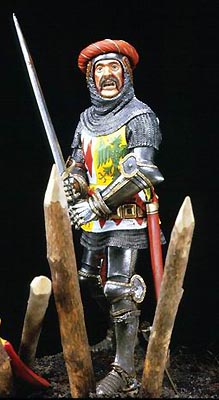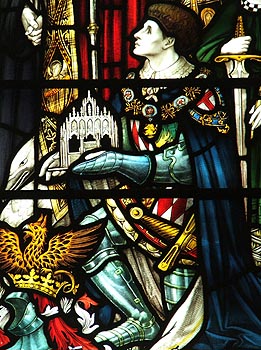 |
 |
|||
|
 Thomas
Montacute, Earl of Salisbury Thomas
Montacute, Earl of Salisbury(1388-1428) Born: 1388 Baron Monthermer Earl of Salisbury Earl of Perche Died: 3rd November 1428 at Tourelles, France Thomas was the elder son of John Montacute, the 3rd Earl of Salisbury, by his wife, Maud the daughter of Sir Adam Francis of London. His father's lands being forfeited for his treason, he received only a portion of them from the King, but further increased his possessions by marrying Eleanor, fourth daughter of Thomas Holland, the 2nd Earl of Kent, and co-heiress of her brother, Edmund Holland, 4th Earl (1384-1408), on 13th May 1399. Having come of age and sworn fealty, the dignity held by his father - including his chief residence of Bisham Manor in Berkshire - was restored to Thomas on 14th June 1409 and he was summoned to Parliament as Earl of Salisbury in the following October. He was made a Knight of the Garter in 1414 and, in May, was appointed joint commissioner to treat with France concerning the rights of King Henry V of England and a marriage between this monarch and Catherine, the daughter of King Charles VI of France. He was in France, again, on this business from July to October. War being decided upon, he engaged, in June 1415, to serve the King with his retinue for one year in France, being paid 12d a day for his own services; and, in July, was one of the seven peers appointed to try the Earl of Cambridge and other conspirators at Southampton, and joined in pronouncing sentence on them on 5th August. On 11th, he sailed from Portsmouth with the King and took part in the Siege of Harfleur and the Battle of Agincourt, where his retinue consisted of three knights, thirty-six esquires, forty men-at-arms and eighty mounted archers. The next year, having again engaged to serve the King, he sailed, in August, with John, Duke of Bedford, who was sent with reinforcements to Harfleur, and took part in the naval engagement with the French at the mouth of the Seine. In February 1417, Thomas attended the Privy Council and, in July, sailed, with the King, for Normandy. He took part in the Siege of Caen and in other operations during that year, being in command of the rear division of the King's army; and received, from the King, the Lordship of Auvilliers. After assisting at the Siege of Falaise, the Earl accompanied the Duke of Clarence, in the Spring of 1418, on a successful expedition against Harcourt, Courtonne, La Rivière-Thibouville and Chambrais; and, on 1st June, received, from the King at Bernay, the grant of Neubourg and two other lordships to be held by the service of presenting the iron head of a lance every Christmas at the Castle of Caen. During the Siege of Rouen, begun on 1st August, Thomas highly distinguished himself, being posted in front of the strongly fortified Abbey of St. Catherine, used as a detached fort, which yielded on 1st September. He was made Warden of the New Forest, Lieutenant and Warden of Evreux and Alençon and, in October, was appointed a joint-commissioner to treat with the Dauphin. The negotiations, which were carried on at Alençon, were fruitless. Early in 1419, Salisbury took Fécamp, Monteville, Gournay, Eu and Honfleur, which he besieged from 4th January to 12th March. In April, he was appointed Lieutenant-General of Normandy and was created Earl of Perche by the service of rendering to the King, each year at the Castle of Caen, a sheathed sword. He was engaged at Rouen in negotiations with the ambassadors of John, Duke of Burgundy, and, in May, accompanied the King to the conference which Henry held near Mantes with the Queen of France and the Duke of Burgundy. The King sent him, in the Autumn, to lay siege to Meulan, joined him there and received the surrender of the town on 6th November In May 1420, the Earl was besieging Frénay with a large force when a French army advanced to its relief, and was defeated by John Holland, Earl of Huntingdon, afterwards Duke of Exeter (1395-1447); and, in July, he was present at the Siege of Melun, which was not surrendered until November. He attended King Henry and his queen, Catherine of France, on their entry into Paris with King Charles of France and Duke Philip of Burgundy on 1at December. In January 1421, Salisbury was at the Parliament held by King Henry at Rouen and, there, did homage for the Earldom of Perche. When the King returned to England shortly afterwards, Thomas remained in France to support the Duke of Clarence. Soon after the King's departure, the Earl of Salisbury marched, with Clarence and a large force, into Maine and Anjou. On 21st March, Clarence insisted on attacking the allied army of the French and Scots at Baugé with his cavalry, without waiting for the rear division under the Earl. He was defeated and slain and, when Salisbury came onto the field of battle, it was too late to retrieve the disaster. Nevertheless, he and the archers under him pressed so vigorously on the French that he was able to bring off the Duke's body. He made an attempt to relieve Alençon, but was intercepted and retreated, not without loss, to Bec. When, however, the besiegers drew off, he again took the field and advanced as far west as the immediate neighbourhood of Angers. Henry V, having died in France in August 1422, and Charles VI of France having died shortly afterwards, Bedford, the Regent of France, marched with Salisbury to recover Meulan from the French. The siege lasted until 1st March, when Salisbury was appointed to arrange terms for the surrender of the place. In June, he was at Paris with the Regent, then newly married, who sent him to besiege the Castle of Orsay. He took it after about three weeks and led the defenders, bare-headed and with ropes about their necks, into Paris. Bedford appointed him Governor of Champagne and Brie, and he went to Champagne and laid siege to Montaguillon, a fortress near Provins. The place was well defended and he had to employ a large siege-train and much ordnance. King Charles intended to relieve it, but was forced to send his army to Crevant-sur-Yonne, which had fallen into the hands of the Burgundians. Salisbury was ordered, by the Regent, to go to the relief of Crevant and received reinforcements under the Earl-Marshal and Lord Willoughby. On 30th July, he appeared before Crevant, made, it is said, eighty knights and attacked the French and the Scots under the walls of the town. He commanded the left wing of his army and, crying "St. George! Avant banner!" dashed into the river; while Willoughby with the right wing forced his way across the bridge. Salisbury gained the bank; the garrison sallied and attacked the besiegers in the rear and his victory was complete. The chief loss fell on the Scots. The English and Burgundians entered the town in triumph and returned thanks for their victory. Salisbury was joyfully received by the Regent and then went back to Champagne, where he carried on the war with success, resuming the Siege of Montaguillon, taking Sézanne by assault and holding the country so vigorously that the French could do nothing against him, specially as, north of him, Suffolk and John of Luxemburg forced their army to retreat beyond the Meuse. In 1424, Salisbury's success continued and, early in the Spring, Montaguillon at last surrendered. The French having seized Verneuil in August, Thomas went to the help of the Regent, who sent him, with Suffolk, to Breteuil to watch the movements of the enemy. On 17th, he took part in the Battle of Verneuil. The division under his command was attacked by the Vicomte de Narbonne, who was slain. The Earl bore the brunt of the battle and the victory of the English is attributed, by a warm admirer, to his ability and valour. Verneuil surrendered upon terms and Salisbury was forced to slay two or three of his men with his own hand, in order to prevent the rest from violating the conditions. He was present, in November, at the festivities given in Paris by Duke Philip of Burgundy to celebrate the marriage of John de la Trémoille. His wife - probably his second wife - was with him. She was a very handsome woman and the Duke courted her. Salisbury was deeply offended and is said to have repaid the Duke by taking part, with the Duke of Gloucester, against him. He completed the subjugation of Champagne, receiving the submission of Montaimé in June 1625. He took Etampes, Rambouillet and other places in the same district, and then made a campaign in the west, taking Beaumont le Vicomte, overrunning Maine and receiving the submission of Le Mans, Mayenne, St. Suzanne and other places. He lost some men by surprise, near Seez, in the course of these successful operations and met with a stubborn resistance at La Ferté Bernard, which was not surrendered until after a siege of three months. When the Duke of Bedford left France in the Winter, Salisbury remained in charge of Upper Normandy and Maine, and, in 1426, took Mondoubleau and also acted with John of Luxemburg in the recovery of Moynier in the county of Virtus in Champagne.
The 4th Earl of Salisbury was the most famous and skilful captain on the English side during the Hundred Years War. Well skilled in war and especially, it would seem from the records of his sieges, in the use of artillery. His support of the Duke of Gloucester was the result of his anger at a personal grievance; but this, combined with his apparently headstrong determination to besiege Orleans, seems to suggest that he was less great as a politician than as a commander. Courteous, liberal and brave, he was beloved by his followers, and was, it seems, generally popular with his countrymen. Though French writers charge him with cruelty, he seems not to have acted otherwise than in accordance with the usages of war, or than other leaders on both sides. His death was held to be an event of supreme importance in the course of the war, the French regarding it as a divine judgment on their most puissant and cruel enemy; the English, as a mark of God's anger and the presage of many calamities. He married firstly, Eleanor the daughter of Thomas, Earl of Kent, by whom be had a daughter, Alice, who married Richard Neville, afterwards Earl of Salisbury, and secondly, Alice, daughter of Thomas Chaucer of Ewelme (Oxfordshire), by whom he had no issue. His widow remarried William de la Pole, Duke of Suffolk, on 11th November 1430. Thomas also left a natural son named John. Edited from Sidney Lee's
'Dictionary of National Biography' (1894)
|
|||
| © Nash Ford Publishing 2001. All Rights Reserved. | ||||




